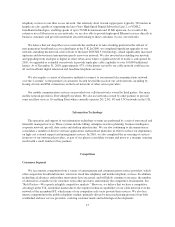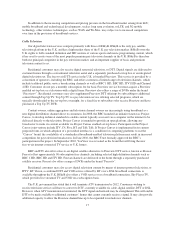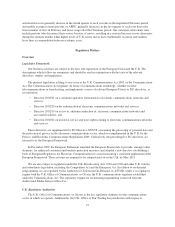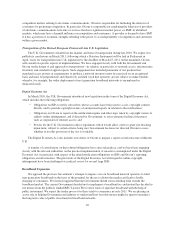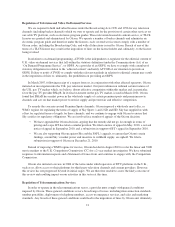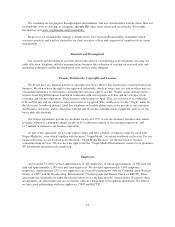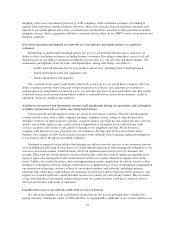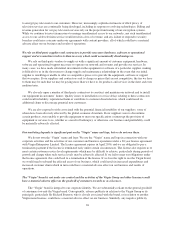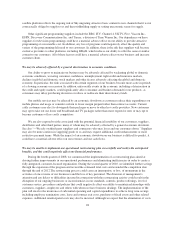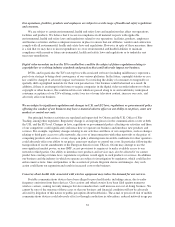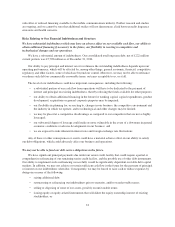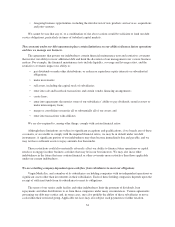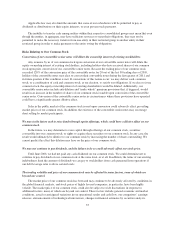Virgin Media 2010 Annual Report Download - page 28
Download and view the complete annual report
Please find page 28 of the 2010 Virgin Media annual report below. You can navigate through the pages in the report by either clicking on the pages listed below, or by using the keyword search tool below to find specific information within the annual report.telephony with voice-over-internet-protocol, or VoIP, telephony, while residential customers are tending to
migrate from fixed line to mobile telephony. However, there is no assurance that our fixed line customers will
migrate to our mobile phones and we may eventually lose our fixed line customers to other providers of mobile
telephone services. Such a migration could have a material adverse effect on our ARPU, results of operations and
financial condition.
If we do not maintain and upgrade our networks in a cost-effective and timely manner, we could lose
customers.
Maintaining an uninterrupted and high-quality service over our network infrastructure is critical to our
ability to attract and retain customers, including business customers. Providing a competitive service level will
depend in part on our ability to maintain and upgrade our networks in a cost-effective and timely manner. The
maintenance and upgrade of our networks will depend upon, among other things, our ability to:
• modify network infrastructure for new products and services, including faster broadband speeds;
• install and maintain cable and equipment; and
• finance maintenance and upgrades.
Our covenants in our senior credit facility effectively restrict our use of cash. If these covenants affect our
ability to replace network assets at the end of their useful lives or if there is any reduction in our ability to
perform necessary maintenance on network assets, our networks may have an increased failure rate. This in turn
could lead to increased customer churn which could have a material adverse effect on our business, results of
operations, financial condition and cash flows.
A failure in our network and information systems could significantly disrupt our operations, and a disruption
or failure of such networks or systems may disrupt our business.
Certain network and information systems are critical to our business activities. Network and information
systems-related events, such as theft, computer hackings, computer viruses, worms or other destructive or
disruptive software, or other malicious activities, or power outages, gas build-up, fire, natural disasters, terrorist
attacks, war or other similar events, could result in a degradation or disruption of our cable and non-cable
services, excessive call volume to call centers or damage to our equipment and data. We do not have a
company-wide disaster recovery plan, however, we continue to develop plans for key areas of risk in the
business. For example, in 2009 we developed a business-wide continuity plan to manage significant disruptions
to our business due to the threat of pandemic influenza.
Sustained or repeated system failures that interrupt our ability to provide services to our customers, prevent
us from billing and collecting revenue due to us, or that otherwise prevent us from meeting our obligations to our
customers in a timely manner, would adversely affect our reputation and result in a loss of customers and
revenue. These network and information systems-related events could also result in significant expenditures to
repair or replace the damaged networks or information systems or to protect them from similar events in the
future. Further, any security breaches, such as misappropriation, misuse, penetration by viruses, worms or other
destructive or disruptive software, leakage, falsification or accidental release or loss of information maintained in
our information technology systems (or those of our business partners) and networks, including customer,
personnel and vendor data, could damage our reputation, result in legal and/or regulatory action against us, and
require us to expend significant capital and other resources to remedy any such security breach. The occurrence
of any such network or information system-related events or security breaches could have a material adverse
effect on our business and results of operations.
Unauthorized access to our network could result in a loss of revenue.
We rely on the integrity of our technology to ensure that our services are provided only to identifiable
paying customers. During the course of 2009 and 2010, we upgraded the conditional access system which we use
25


